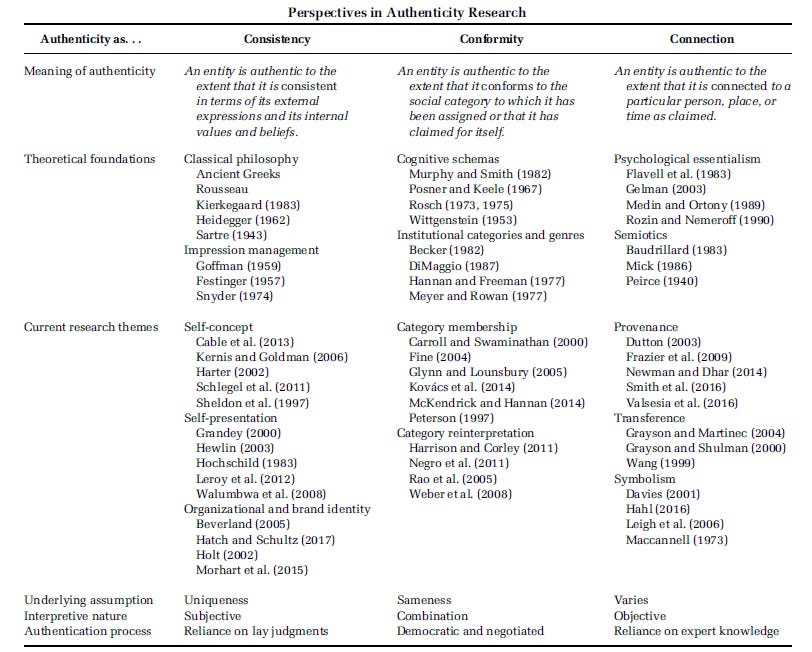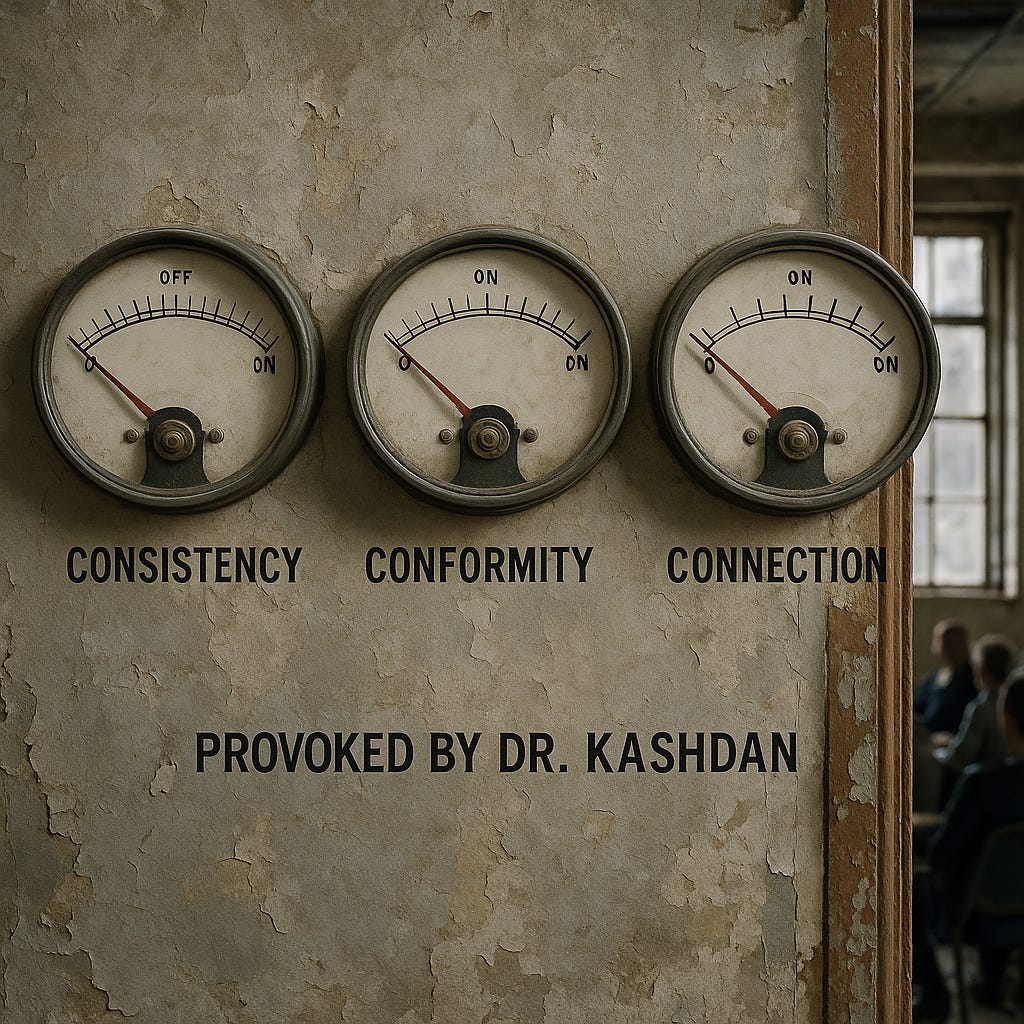The Enigma of Being Yourself: Lessons on the Ridiculous Topic of Authenticity
In case you missed it…
Provoked is fully reader-supported. If you enjoy this article, support the mission (be a free subscriber or get premium benefits).
There is no better way to open on the psychology of authenticity than this quote from Dr. George Newman:
The topic of authenticity is fascinating for reasons that transcend its practical significance. Consider, for example, the difference between an original Picasso painting and a perceptually indistinguishable forgery. Provided that the viewer is unaware of which one is which, both paintings will inspire the same cognitive and affective responses. As such, the value assigned to each painting should (in theory) be the same, corresponding to the utility that the image provides. Yet, learning about a painting’s true history—that is, whether it is an original or a forgery—results in a dramatic difference in how people value the paintings and moreover, a difference in the pleasure that people get when viewing them.
Take that example from the creative arts and apply it to humans…
The “True” Self
Few words are abused like authenticity. Not because the idea is rotten. Because we’ve turned it into spiritual cologne. A CEO blurts half-baked “radical candor,” calls it authentic and leaves a team bleeding. A teenager who makes more money than her 50-year-old parents sets up a ring light to cry on camera, then adds #authentic. Your cousin “just being honest” at dinner is using authenticity as a hall pass for low impulse control. And my favorite: employees who show up unprepared without reading pre-meeting readings sent, shrug, and say, “I’m my authentic self with a lot going on.” That is, they didn’t do the work and you, with just as much on your plate, must increase your own load.
If “be yourself” is the operating system, no wonder democracy is in crisis.
Here’s an upgrade. Authenticity is not one thing; it is three different games that people mix up, which is why so many attempts at “realness” go sideways. Across psychology and management science, the construct chunks into three distinct meanings. Consistency. Conformity. Connection.

Consistency means alignment between your inner values and outer behavior.
Conformity means you resemble the norms of a category, what the so-called average person is saying or doing.
Connection means your story links to a person, place, or time as claimed.
They’re separate dials your audience uses to judge you, your product, or your performance. Turn one dial and you may knock the other two out of tune.
Let’s ground this with a delicious, perverse scientific finding. Put a viewer in a scanner. Show them a Rembrandt portrait. If you whisper “copy” in their ear, the brain treats the same pixels differently than when you whisper “authentic.” Same image. Different meaning. The “copy” label provokes stronger responses in the frontopolar cortex (Psst…I never heard of it before reading this either) and shifts the conversation between frontal and visual areas, changing pleasure and attention. Belief about the origin of something that grabs your attention alters the experience. That’s connection authenticity rewriting perception, and it can be used to improve your moments or manipulate the fuck out of you (source).
This is why a $30 “hand-pulled” noodle can feel more “real” than a better-tasting $12 bowl. If your menu, décor, owner story, and chef’s technique line up with what people expect from “authentic Sichuan,” you get categorical points, even if grandma’s recipe would disagree. When a Brooklyn brewery puts out a “heritage lager” but sources hops from wherever are cheapest, drinkers sniff out the broken connection. The beer might taste fine. The story tastes off. Three dials, people…use them all!
So how does authenticity get abused?
Cheap vulnerability as a strategy. You disclose a personal failure because the playbook says “be vulnerable.” But disclosure without discernment feels theatrical. It is not the same thing as consistent. If your team’s takeaway is that they now have to manage your emotions, you were authentic to your anxiety, not to your role.
Weaponized honesty. “I’m just being real” is often cruel. Authenticity was never carte blanche to ignore interpersonal skills. There’s a reason audiences prize people who adapt to the situation (are you speaking to coal miners or pediatric nurses? better not give the same talk). The best performers shape themselves to the room without selling their soul. The science is unromantic here. People who track how they are seen and adjust tend to succeed more than those who cling to their “true self” like a security blanket (source from the 1983 wayback machine). More on that in the reversal.
Category confusion. Startups claim to be “authentic” because the founder grew up working-class. That’s connection, not consistency, and it doesn’t excuse a misleading pricing model. Restaurants brag about “authentic” recipes while serving food that perfectly fits Instagram’s idea of Thai. That’s conformity to a stereotype, not connection to a tradition or values. An Academy of Management review documents exactly these splits across industries, and shows how each meaning carries different assumptions about who gets to judge and what counts as evidence.
Feelings mistaken for facts. People report feeling most authentic when they act socially desirable.
We all love our “true self” when kind, brave, or generous. Less so when we’re petty or vengeful. It’s a reminder that the subjective sense of being authentic often floats free of what you are doing, and sometimes free of reality testing.
Researchers have been blunt about the gap between felt authenticity and actual behavior. Your inner “I feel real” meter is not a life detector. This concept ties in with a theme by one of my favorite thinkers in the social sciences, Dr. Tomas Chamorro-Premuzic. His book is titled:
Don’t Be Yourself: Why Authenticity Is Overrated (and What to Do Instead)
While you wait for the book to arrive, let’s zoom in on the three dials and how to use them and improve your social intelligence.
Consistency. Ask a boring, high-standard question. If a stranger audited my browser history, would they see my stated values? Don’t tell me you value mentoring if there’s no recurring time block with names in it. Don’t preach customer obsession if you never listen to support calls. Consistency is built in dull, repeatable habits that survive busy days. The more you can point to observable, repeated signals, the less you need to speechify about your “authentic self.”
🔒 For the Curious
If you want to go beyond the basics, read on. You will also get concrete strategies, including:
Responding to authenticity obsessions in the workplace
The Three-Dial Audit
The Storytelling Scanner
Evidence Block Scheduling


